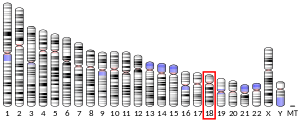Zinc finger protein 516
Zinc finger protein 516 is a protein that in humans is encoded by the ZNF516 gene.[5]
Function
Zinc-finger proteins bind nucleic acids and play important roles in various cellular functions, including cell proliferation, differentiation, and apoptosis. This gene encodes a zinc-finger protein, and belongs to the Krüppel C2H2-type zinc-finger protein family. It may be involved in transcriptional regulation.
gollark: Works for me ish.
gollark: `null` may be comparable in total damage to human society to some lower-end dictators.
gollark: Ah, thus esolangs?
gollark: Idea: Godwin's law but for apioforms.
gollark: I sort of like writing JS but feel guilty about it because my code will inevitably break when it hits an error condition of some sort and/or a dependency implodes, Rust is a much nicer language in various ways but stricter when I *do not actually care* about shaving off a few ms and garbage collection is fine, I tried OCaml but the tooling isn't *great* and the libraries seem to be lacking.
References
- GRCh38: Ensembl release 89: ENSG00000101493 - Ensembl, May 2017
- GRCm38: Ensembl release 89: ENSMUSG00000058881 - Ensembl, May 2017
- "Human PubMed Reference:". National Center for Biotechnology Information, U.S. National Library of Medicine.
- "Mouse PubMed Reference:". National Center for Biotechnology Information, U.S. National Library of Medicine.
- "Entrez Gene: Zinc finger protein 516".
Further reading
- Shaffer JR, Feingold E, Wang X, Lee M, Tcuenco K, Weeks DE, Weyant RJ, Crout R, McNeil DW, Marazita ML (January 2013). "GWAS of dental caries patterns in the permanent dentition". Journal of Dental Research. 92 (1): 38–44. doi:10.1177/0022034512463579. PMC 3521449. PMID 23064961.
- Shi Y, Sawada J, Sui G, Affar el B, Whetstine JR, Lan F, Ogawa H, Luke MP, Nakatani Y, Shi Y (April 2003). "Coordinated histone modifications mediated by a CtBP co-repressor complex". Nature. 422 (6933): 735–8. doi:10.1038/nature01550. PMID 12700765.
- Nagase T, Seki N, Ishikawa K, Ohira M, Kawarabayasi Y, Ohara O, Tanaka A, Kotani H, Miyajima N, Nomura N (October 1996). "Prediction of the coding sequences of unidentified human genes. VI. The coding sequences of 80 new genes (KIAA0201-KIAA0280) deduced by analysis of cDNA clones from cell line KG-1 and brain". DNA Research. 3 (5): 321–9, 341–54. doi:10.1093/dnares/3.5.321. PMID 9039502.
- Lee MG, Wynder C, Cooch N, Shiekhattar R (September 2005). "An essential role for CoREST in nucleosomal histone 3 lysine 4 demethylation". Nature. 437 (7057): 432–5. doi:10.1038/nature04021. PMID 16079794.
- Yashin AI, Wu D, Arbeev KG, Ukraintseva SV (September 2010). "Joint influence of small-effect genetic variants on human longevity". Aging. 2 (9): 612–20. doi:10.18632/aging.100191. PMC 2984609. PMID 20834067.
- O'Brien RP, Phelan PJ, Conroy J, O'Kelly P, Green A, Keogan M, O'Neill D, Jennings S, Traynor C, Casey J, McCormack M, Conroy R, Chubb A, Ennis S, Shields DC, Cavalleri GL, Conlon PJ (2013). "A genome-wide association study of recipient genotype and medium-term kidney allograft function". Clinical Transplantation. 27 (3): 379–87. doi:10.1111/ctr.12093. PMID 23432519.
This article incorporates text from the United States National Library of Medicine, which is in the public domain.
This article is issued from Wikipedia. The text is licensed under Creative Commons - Attribution - Sharealike. Additional terms may apply for the media files.



